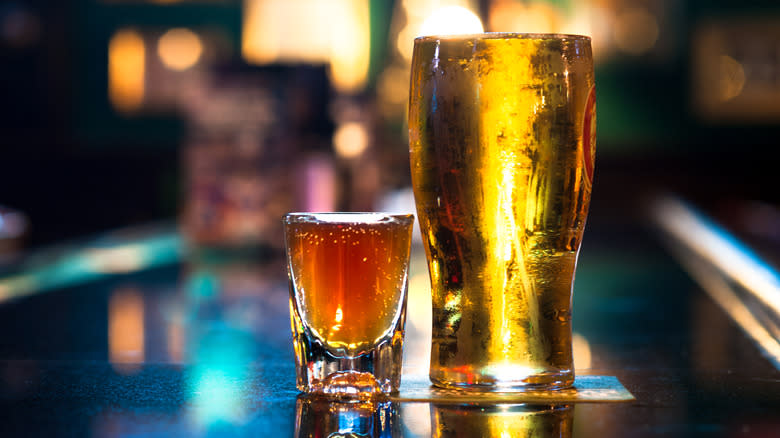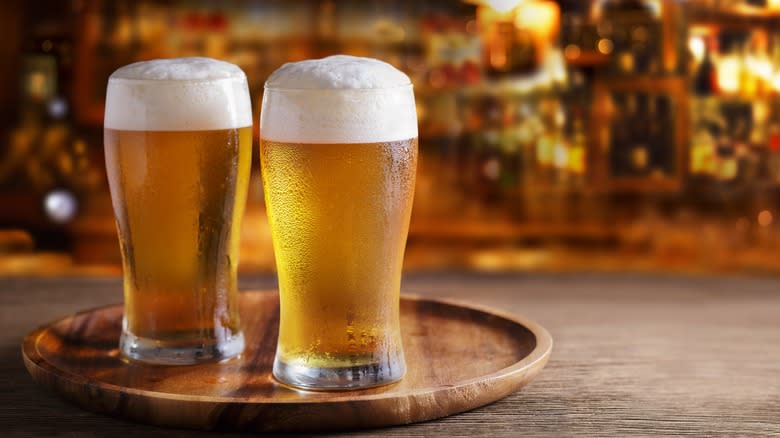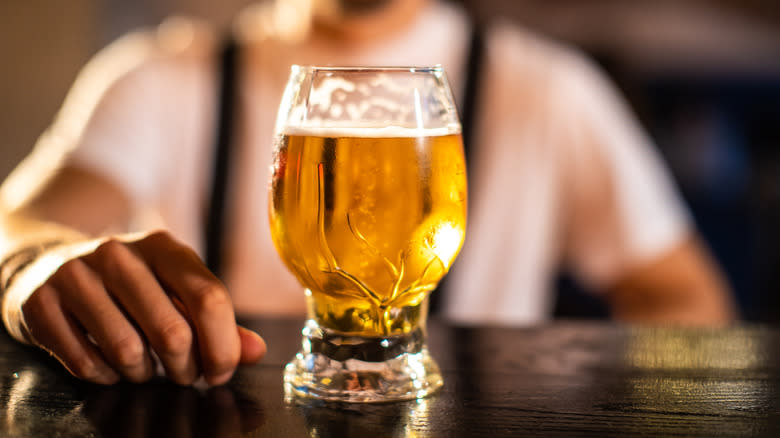How Much Beer You'd Have To Drink To Equal A Single Shot Of Liquor

Consuming alcohol should always be done responsibly, and it helps to know what the different alcohol types — and quantities — actually mean. Whether you're indulging in your favorite beer, sipping on a glass of wine, or enjoying a liquor-based cocktail during happy hour, not all alcohol types are created equal when it comes to their alcohol by volume (or ABV) percentage. Generally speaking, the National Consumer League reports that one 12-ounce beer is equal to one shot, though this varies depending on the specific ABVs of both the liquor and the beer. However, the alcohol content directly impacts how much of a particular liquor you can safely consume. For example, a beer with 4% ABV will affect you less than a beer that's 8% ABV. While health institutions don't necessarily condone drinking, the CDC does say that men should consume no more than two drinks per day — and women just one drink per day — to reduce the risk of potential health issues from alcohol.
Read more: 10 Of The Healthiest Beers You Can Drink
One Beer Usually Equals One Shot Of Liquor

Alcohol by volume refers to the amount of ethanol for every 100 milliliters of liquid. Liquor tends to have a much higher ABV (usually around 40%) than beer (usually around 5%), which is why taking a sip of beer is much easier than taking a sip of straight vodka.
Here's where things get tricky: This rule of thumb that one beer equals one shot refers to a very general assumption that one 12-ounce beer equals 5% ABV. Popular beers like Michelob, Budweiser, and Heineken are all 5% ABV, but lighter beers, such as Coors Light, Miller Lite, and Bud Light, are 4.2% ABV and contain fewer calories and carbs. More important, though, is the understanding that plenty of beers contain far more than 5% ABV. Specifically, many craft beers tend to have higher alcohol percentages; Allagash Brewing Company's Tripel contains 9% ABV, but some craft beers contain upward of 11%. The National Institute of Alcohol Abuse and Alcoholism provides a calculator for determining how many "standard drinks" a beer is equal to based on its alcohol percentage. The actual conversion to liquor varies depending on the beer's ABV and the liquor's ABV.
With that said, different liquors also have different ABVs, with some higher than 40%, known as overproof, and some lower than 40%. It's essential to understand the exact ABV content of your drink in order to know how it will impact your body.
How Does Beer Get Its ABV?

The beer-making process determines its ABV. Beer is made from barley, a sugar-filled grain that ferments over time with the help of yeast. As the barley ferments, the yeast feeds on the sugar and turns it into alcohol. The length of the fermentation process, plus the type of yeast used, can impact not only a beer's flavor but also its alcohol content.
A beer's ABV directly impacts your body's blood-alcohol level or BAC. If you've ever heard of someone "driving under the influence," it might mean their BAC was above 0.08%. Your gender and weight directly impact your BAC. A blood alcohol chart shows a female weighing 140 pounds can likely have two drinks while remaining under the legal limit, whereas a male who weighs 180 pounds might be able to have up to four drinks. But in any case, it's assumed that a "drink" refers to either a 12-ounce, 5% ABV beer or a 1.5-ounce, 40% ABV shot of liquor.
Read the original article on Daily Meal.

